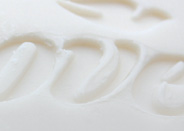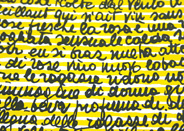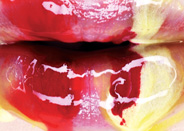|
|
|
user instructions
Il Packaging del Piacere
Sonia Pedrazzini, Marco Senaldi
shopping bag
Dove è Cura & Benessere
Sonia Pedrazzini
show box
Borotalco
shopping bag
I Sensi della Carta
identi-kit
Lo Zen e l’Arte del
Comunicare Piacere
Teresa Cuccovillo
new!
“I’m lovin’ it” McDonald’s e i
Semplici Piaceri della Vita
identi-kit
Vuoto a Rendere
Marco Senaldi
warning!
Lussi, Lussurie e Piaceri
Patrizia Calefato
identi-kit
La Marca nella Mente
Sonia Pedrazzini
tools
Liza Lou, Fanciulla Operosa
Lara Facco
show box
Blister 2004
shopping bag
Peccati non Solo di Gola
Sonia Pedrazzini
identi-kit
La Cognizione del Gusto
Marco Senaldi
design box
What is Packaging Design?
flash
Non è borotalco
Antonio De Pascale
design box
Patatine e Champagne
Olav Jünke, Francalma Nieddu
school box
Muthesius Hochschule
identi-kit
Ghada Amer. Index of Pleasure
Marco Senaldi
tools
E il verbo si Fece Cioccolata
Maria Gallo
bookbox
|
|
Le nostre copertine
Front cover
Tiffany Value Meal Hires, 1998
Tom Sachs
Back cover
Index of Pleasure, 2002
Ghada Amer
Ringraziamenti
Patrizia Ledda e MAP Comunicazione
Libreria Tuttolibri Piacenza
Massimo Minini

 |
|
|
 |
guida turistica attraverso
i panorami reali e mentali del packaging
tourist guide to the real
and spiritual landscapes
of packaging |
 |
 |
|
|
user instructions
|
|
|
Il Packaging del Piacere
Sonia Pedrazzini, Marco Senaldi
Cosa c’è di più difficile da definire del piacere? Non è un concetto universale, non è sempre condivisibile, è opinabile, è soggetto al tempo, allo spazio, alle persone. Non è assimilabile al godimento vero e proprio, di cui rappresenta la parte più recondita e privata, ma non è nemmeno riducibile al sesso, al divertimento o al senso del lusso. Eppure tutti sanno cosa sia quel brivido che esalta lo spirito o che rilassa il corpo, quel benessere intenso che per poco o per molto allontana dagli affanni e dalle tensioni. Sensazione intima, personale, equilibrata, nell’ambito dei beni di consumo il piacere sta prendendo il posto una volta occupato dalla retorica pubblicitaria dell’originalità, della personalità, dell’efficacia o della convenienza. Il fortunato slogan che promuove un’auto di tendenza suona non a caso “Il piacere è tutto mio”, giocando sull’ambiguità fra soggetto (acquirente) e oggetto (auto), come se la fruizione del piacere fosse transitiva e interscambiabile: a dichiarare la propria disponibilità al piacere è sì l’auto, ma anche il compratore che dovrebbe usufruirne.
Il piacere insomma è una dimensione emotiva a due facce; gli oggetti, le merci, i beni di consumo legati al piacere si rivolgono a chi intende servirsene mediante una corrispondenza d’amorosi sensi, parlano una lingua emotiva esattamente a chi sa intenderla. Perciò il piacere diventa una tendenza di marketing: è immediato, sigla un rapporto confidenziale fra consumatore e oggetto di consumo, che sia quest’ultimo un sigaro o un gelato, una crema idratante, un’auto o un caffè; è liberatorio, emancipa dal dovere sociale dell’esibizione e dalla schiavitù dello status symbol; è riservato, si colloca nella più generale tendenza verso un approccio slow dell’esistenza contemporanea e dei suoi - appunto - piaceri. Benché questi ultimi possano dunque appartenere a generi diversi - piaceri della tavola, del bere, del corpo, della mente o persino dello spirito -
il loro carattere comune consiste nell’idea di una pausa dall’insostenibile pesantezza della convivenza sociale.
Il packaging legato a oggetti che forniscono piacere tende a divenire, per analogia o somiglianza, per contiguità o assonanza, anch’esso un oggetto di piacere, dal quale in taluni casi si ha qualche remora a sbarazzarsi: difficile buttare il prezioso flacone di profumo, o l’elegante vasetto di crema, come pure è difficile gettare la custodia in alluminio satinato di un buon sigaro, anche quando quest’ultimo è già cenere da tempo. Giusta reazione: perché il piacere è una dimensione invasiva del quotidiano e potenzialmente sovversiva, che non si lascia ridurre all’intermezzo tra, ma tende a prevaricare, a sbordare dai limiti dove l’etica del lavoro e le responsabilità sociali vorrebbero confinarlo. Gli artisti hanno capito da tempo tutto ciò fino a condurre la provocazione alle estreme conseguenze: prova ne sia il lavoro di Tom Sachs, enfant terribile della scena internazionale, che con le confezioni delle marche più raffinate ricostruisce pazientemente trompe-l’oeil di oggetti cheap come il classico vassoio MacDonald's: testimonianza evidente dello strabismo emotivo del consumatore postmoderno.
The Packaging
of Pleasure
Sonia Pedrazzini, Marco Senaldi
What is more difficult to define than pleasure? It is not a universal concept, it cannot always be shared, it is a matter of opinion, it changes with time, space and the individuals concerned. It cannot be equated with enjoyment, of which it represents the most secret or private part, but neither can it be put down to sex, amusement or a sense of luxury. Yet everyone knows that frisson which exalts the spirit or relaxes the body, that intense feeling of wellbeing which for a shorter or longer time takes away worry or tension. An intimate, personal, balanced sensation, in the context of consumer goods pleasure is taking the place once occupied by advertising rhetoric about originality, personality, effectiveness or convenience. It is not by chance that the successful slogan promoting a trendy car is "The pleasure is all mine", playing on the double meaning of the subject (the purchaser) and the object (the car), as if the use of pleasure can be transitive and interchangeable: announcing the availability of the car itself to please, but also the buyer who will use it. So pleasure is an emotive dimension with two faces: the objects, the merchandise, the consumer goods linked to pleasure attract themselves to those who are to use them through a relationship of loving senses, they speak an emotive language precisely to those who know how to understand it. Thus pleasure becomes a marketing trend: it is immediate, it signals a confidential relationship between the consumer and the object of consumption, whether this is a cigar or an ice cream, a moisturising cream, a car or a coffee; it is liberating, it frees the consumer from the social need for the display and slavery of the status symbol; it is reserved, and takes its place in the more general trend towards the ‘slow’ approach to modern living and its pleasures. Although these previously mentioned pleasures may seem to be different - the pleasures of the table, of drinking, of the body, of the mind or even of the spirit - they share a common characteristic in the idea of a break from the insupportable weight of social co-existence. The packaging linked to objects which provide pleasure tends to become, by analogy or similarity, by proximity or assonance, in itself inevitably an object of pleasure, which in some cases we are loath to part with: it is difficult to throw away that precious perfume bottle, or a stylish cream jar, how difficult it is to throw away the satin finish aluminium tube from a good cigar, even when the cigar itself has been just ash for a long time. This is a reasonable reaction: because pleasure is an invasive, and potentially subversive, dimension of daily life, which will not allow itself to be reduced to a mere interlude, but tends to abuse its power, to break free of the bounds of where the work ethic and social responsibility try to keep it tethered. Artists have understood for a long time how to drive provocation to extreme consequences: this is shown in the work of Tom Sachs, enfant terribile of the international scene, who with the packaging of the most sophisticated brands patiently creates trompe-l’oeil of cheap objects such as the classic MacDonald's tray: clear evidence of the emotional skewness of the post-modern consumer.
|
|
|
|
user instructions
The Packaging of Pleasure
Sonia Pedrazzini, Marco Senaldi
shopping bag
Dove is Care and Wellbeing
Sonia Pedrazzini
show box
Borotalco
shopping bag
The Senses of Paper
identi-kit
Zen and the Art of
Communicating Pleasure
Teresa Cuccovillo
new!
I'm lovint'it: McDonald's and the Simple Pleasure of life
identi-kit
Returnable Empties
Marco Senaldi
warning!
Luxuries, Luxuria and Pleasures
Patrizia Calefato
identi-kit
The Brand in the Mind
Sonia Pedrazzini
tools
Liza Lou, Hardworking Maid
Lara Facco
show box
Blister 2004
shopping bag
Sins Not Just of Gluttony
Sonia Pedrazzini
identi-kit
The Cognition of Taste
Marco Senaldi
design box
What is Packaging Design?
flash
Non è borotalco
Antonio De Pascale
design box
Fries and Champagne
Olav Jünke, Francalma Nieddu
school box
Muthesius Hochschule
identi-kit
Ghada Amer. Index of Pleasure
Marco Senaldi
tools
And the Word Turned to Chocolate
Maria Gallo
bookbox
|
|
|
Our covers
Front cover
Tiffany Value Meal Hires, 1998
Tom Sachs
Back cover
Index of Pleasure, 2002
Ghada Amer
Thanks to
Patrizia Ledda e MAP Comunicazione
Libreria Tuttolibri Piacenza
Massimo Minini
|